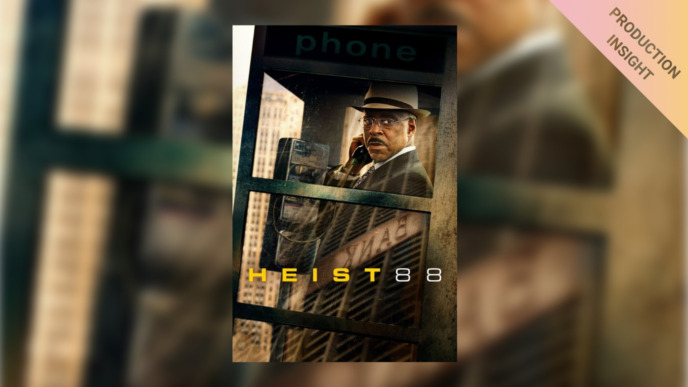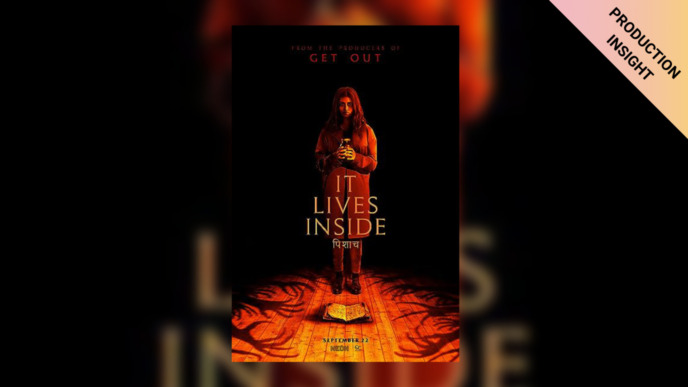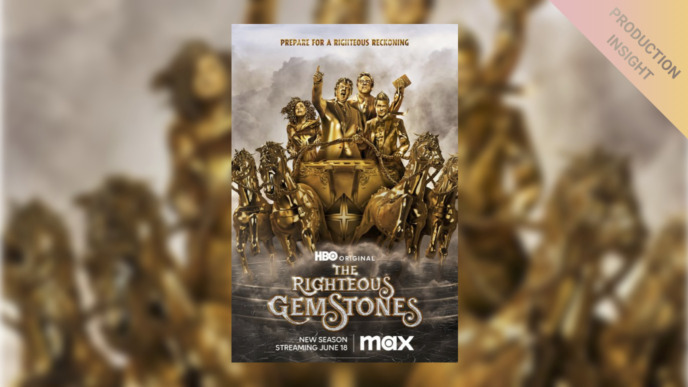
Artificial storms, sinking ships, water all around – the feature film “La Encomienda” was shot in a massive water tank at Pinewood Dominican Republic. The responsible DIT, Bhima Gandica, takes us behind the scenes and explains how he navigated this demanding production environment.
Bhima used Livegrade Pro, Silverstack Lab, and Pomfort’s cloud service to design a workflow of maximum efficiency. With the cast and crew in the water most of the time, there’s simply no room for mistakes or delays. So, let’s dive in!
Thanks for sharing some insights into your projects with us! Can you tell us a bit about yourself and your work first?
Thanks Pomfort for interviewing me. I am always happy to share what I’ve learned!
I’m a Venezuelan director and cinematographer living in the Dominican Republic. My education took place in many different locations and circumstances. However, being the child of artists and filmmakers, I’ve always been surrounded by a creative environment, which sparked my interest in cinematography. I formalized my knowledge by filming in my hometown Mérida. Back then, we made films in a pretty “hippie” way: During the week, we earned money doing commissions for TV and commercials, and on weekends we filmed whatever we liked on the patio of a friend’s house, Inti Torres Melo. We were actors, directors, sound engineers, writers, working freely and with small teams – we had a lot of fun. I also attended workshops at the International Film and Television School of San Antonio de los Baños Cuba, where I was sent by my mentor Edmundo Aray, a Venezuelan filmmaker and poet for whom I edited frequently.
Just before moving to the Dominican Republic, I directed a short film called “El Vuelo de los Cangrejos” (The Flight of the Crabs). The film obtained many acknowledgments and awards in festivals around the world, which opened new doors for me. I then went to work as a post supervisor and DIT for a film and post-production company, which was founded within the facilities of an important studio where national and international films were made. There I was able to concentrate 100% on the more technical aspects of filmmaking.
What kind of projects are you usually working on?
Usually, I work on feature films. I work a lot as a post producer, either finalizing films as a post supervisor or in editing. These experiences, in combination with my skills as a photographer, have really made me understand the importance of having a DIT on set. So whenever I have a job as a DIT myself, I take into account and apply my previous experiences.
Lately, I have also worked on many music videos by artists like Shania Twain, John Legend, Dj Tiesto, Maluma, etc. For the latest videos, I’ve used Livegrade Pro to help me apply a “show look” to the signal and thus provide peace of mind to the DP. Faced with the COVID-19 pandemic, many producers prefer not to attend the set and instead watch everything via streaming.

You recently worked on a production called La Encomienda, on which you used Livegrade Pro, Silverstack Lab, and a previous version of our cloud service (since replaced by ShotHub). Can you tell us a bit about this project? How did the team come together, and what role did you play?
“La Encomienda” is a film that brought me many fulfillments, one of them being the technical neatness that we were able to achieve. I never had a return from the editor María Astrauskas, who received dailies in Argentina to edit on Avid through Dropbox. The workflow for “La Encomienda” was designed with awareness of what we were going to shoot. I had already shot another feature film with Diego Poleri as director of photography, but we knew this movie would be different. It was filmed in the south lot of Pinewood Studios in the Dominican Republic and was mainly shot in the water. This created special challenges:
For example, things always had to happen very quickly. The camera was in a diving enclosure that takes 30 minutes to open and close when filming underwater. There was a lot of wet stuff, wet hands, things splashing, and people eager to complete the shooting plan on time. Hence, all movements had to be executed with more caution. The security standards are usually demanding in these facilities, so the DIT has to be agile, careful, and technically capable. There is no room for mistakes. Thanks to Pomfort, I was able to work confidently and securely. Pomfort’s applications have no functions from which you can expect a failure; everything does what it says it will do. Even in unforeseen events, issues can be reported to Pomfort, and someone will quickly reply with a solid solution. Overall, I was in charge of a range of tasks: Data wrangling, live grading, and streaming.

How was the decision made to use a combination of Silverstack Lab, Livegrade Pro and the cloud? Were there specific requirements for the use of each application?
Imagine having your actors and a team of divers in the deep water tank waiting for a decision from the script team. The script supervisor (who was located in a floating video village) often needed to see stills almost immediately. Hence, being able to transmit the metadata and libraries from Silverstack to Pomfort’s cloud was amazing. The Script Supervisor and other team members, such as the art department and set decorators, were able to access stills directly on their phones or tablet. The photographer Diego Poleri and director Pablo Giorgelli also needed dailies almost immediately. Using Livegrade Pro (the Studio version did not exist yet) and its perfect timecode-based look matching feature in combination with Silverstack Lab was fundamental to our work as it allowed us to create dailies almost in real-time! This was extraordinary, or as Diego Poleri liked to say: “Bhima, the future is now, and you are part of it!”

How was your overall experience working with the Pomfort applications? Were there any features that you used frequently or liked in particular?
There’s a little Pomfort App called LiveGrade Air1, which also played a really fun role in this project: I exported stills from Silverstack as they came from the camera, using Original Color as the color setting in the stills export preferences. These stills went to a Dropbox folder organized by shooting day with the clips named by scene-shot-take. This folder was synched on the iPad with the Dropbox app. LiveGrade Air allowed me to take the stills, grade them and then export a LUT to be used in Silverstack later on. Oftentimes, the set was a ship that was literally sinking or a boat that was about to face an artificial storm. So I often walked through the tank with water up to the waist, then did some fixes or experiments on the material with the DP, who was also completely soaked most of the time. With wet feet, I’d then return to my workstation to apply those LUTs in Silverstack Lab. Being able to do that was wonderful.
Furthermore, the peace of mind that Silverstack Lab gave me with its card duplication functions is unique. Silverstack Lab allows you to perform a perfect copy and verification, while you can suspend and resume copy jobs. In addition, the automatic audio synch feature ensured that everything was synched smoothly – and within seconds (don’t tell the sound engineers, please).
Hence, there were no big synchronization and export sessions. There were no overtime hours. The possibility to take over slate metadata of the sound files to the metadata of the video is also truly extraordinary. If you are rigorous, you will never have a problem with the deliveries. There’s also another feature that I personally love, which is the possibility of organizing the dailies (or any material) by sequences, and also that these folders are updated without you having to worry. You just know that the material will be organized in an almost automated way, adding the new material while leaving the previous clips intact (once you have set it correctly) and in as many destinations as you prefer. So I was able to copy to a travel drive and to Dropbox simultaneously. I must also mention that the way Silverstack Lab handles the metadata is special. Having all main export formats available further allows you to prepare your material for any editing software. This again provides peace of mind as you know that everything will work correctly in all cases.

Which cameras were used in this project?
We used the Alexa Mini with Cooke S4 optics, as it was the best fit for the project. I’m going to leave you the details of the settings that we used. However, it was nothing to write home about; I think it was pretty standard.
Sensor Mode: ARRIRAW OG 3.4K: 3424 x 2202
Project frame rate: 24 fps
Recording Codec: ARRIRAW (.mxf) up to 48fps ProRes 4444 XQ for 100 (project 24 fps fps), we always changed cards when changing this setting.
Medium: CFAST 256gb (00:14:56) 977.3 GB / h (based on Project Rate), always emptied at 70%
Image Processing: 16 bit linear in ALEXA Wide Gamut / Log C color space.
Target output color spaces: ACEScct 1.1 (Color), ODT Rec 709 (Proxies) with CDL values or 3D LUT for each scene. The editor requested the “editorials” to be how it was filmed, so I had to provide a LUT for each scene.
Audio: not embedded (must be disabled in camera) audio .wav. The premix must be embedded in channel 1 & 2. With poly recording on the audio recorder. Everything was synched via TentacleSync devices that allowed us to leave it on camera and put it in the Gate Under water for Alexa Mini diving enclosure by Pj Gaffers.
Can you please briefly describe your on-set workflow on the production? For which aspects of your work did you use each application? What did you use the cloud for?
The setup consisted of the following: A MacBook Pro with 32 GB RAM, a G-SPEED Shuttle XL with Thunderbolt 3 connectivity, on which a RAID was mounted, and a G-Drive-ev series travel drive to deliver dailies to the production, direction, and photography departments. Finally, a Terramaster TD2 Thunderbolt 3 enclosure with two JBOD drives for B backup. Everything was arranged in rack-type cases, which allowed for quick closing and storage.
The live grading job was achieved by receiving the video signal via a Teradek Bolt 1000 unit and an FSI BoxIO connected to Livegrade Pro via wifi. As two signals had to be managed at the same time without the possibility of having multiple monitors, I used an FSI DM240, which offers the possibility of displaying two video sources at the same time and handling a color space coming from ACES, P3, or Rec.709. The SDI 1 input had the signal coming from the Teradek -> BoxIO-> Livegrade Pro -> BoxIO -> DM240, and from there it went to streaming through a BlackMagic ATEM that received, in turn, a referential audio signal and a signal from a webcam that was placed, so that whoever was receiving the streaming could see the set at the same time. The SDI input 2 got the signal coming from Silverstack Lab through a Blackmagic UltraStudio 4k Mini. This allowed me to make direct comparisons on the same monitor of frames or the entire scene and its correlatives, even though they were not filmed on the same day and the material coming from the camera. In turn, I sent this signal to the ATEM to be able to transmit it via streaming if necessary.

Were there any particularly challenging situations or setups on this project?
Filming in the water is always more complex as things do not go at the speed you’d expect. You would think that swimming 10 meters is nothing, but imagine that an actor has to do three takes and then three more shots. On top of that, everything moves, everything floats, and whatever falls into the water, you can say ‘goodbye’ to (how many cell phones look at us from phone heaven). The salinity of the marine environment can also destroy your equipment, so you must always be prepared with a plan B, a plan C, and much contact cleaner. You must be willing to collaborate in every aspect, shake hands with the one next to you, and have a lot of contact cleaner (Did I mention that already?).


When you think back to the filming of La Encomienda, what is your most memorable experience? What did you enjoy the most?
The companionship was key. It turns out that Pablo and I had the same model of guitars, a good pair of Gretch Electromatics, so we had great Blues moments while waiting to prepare for the set. I think filming while you enjoy yourself is key; everything turns out more beautiful, everything flows better. I hope that in the future I’ll have more productions like “La Encomienda”.
A film set is organic, and each production is unique; they all have different needs. There were times where I had to convert my vehicle into a DIT station and others where I had to sail into a storm on a catamaran (not recommended). And then there are others where I have to work with a laptop on my legs. You will not always have the ideal conditions, but you should always have reliable tools and alternative plans to meet the production’s delivery objectives and, above all, safeguard the material. A movie is like a train; it does not stop, you cannot get off, and we are all going on it, in the same direction and at the same speed. You must be part of the solutions and smile.

Big “Thank You” to Bhima for sharing his experiences with us!
____________________________
[1] LiveGrade Air reached its end of life and is not available any more.
Bhima Gandica
Bhima Gandica is a DIT, Director and DP born in Mérida, Venezuela. He has proven experience in multiple film-related fields and is a specialist in camera and new-generation digital cinema. Over the years, he has directed short films and TV series for different production companies.
IMDb Profile
Instagram Profile



